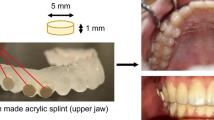Abstract
Streptococcus mutans is the primary etiological agent responsible for dental caries. Microfluidic devices have been used to provide a level of control over bacterial microenvironments under laminar flow conditions. In this study, we used a microfluidic device packed with glass beads to simulate the interproximal space, which is the space between the teeth. In the device, the effects of environmental factors, such as sucrose and metal ions, on S. mutans attachment and biofilm formation were quantitatively measured using confocal laser scanning microscopy and atomic force microscopy. We determined that sucrose was required for both bacterial attachment and exopolysaccharide (EPS) production in S. mutans. These results suggest that the in vivo condition between the teeth was successfully mimicked and that the device is highly suitable for in situ monitoring of oral biofilms.
Similar content being viewed by others
References
Thomas, J.G. & Nakaishi, L.A. Managing the complexity of a dynamic biofilm. JADA. 137, 10S–15S (2006).
Prasad, S., Peter, C.M., Hansen, H., Meaden, P.G. & Austin, B. A novel bacteriocin-like inhibitory substance (BLIS) from a pathogenic strain of Vibrio harveyi. Microbiology 151, 3051–3058 (2005).
Murchison, H., Larrimore, S., Hull, S. & Iii, R.C. Isolation and characterization of Streptococcus mutans mutants with altered cellular morphology or chain length. Infect. Immun. 38, 282–291 (1982).
Davey, M.E. & O’Toole, G. Microbial biofilm: From ecology to molecular genetic. Microbiol. Mol. Biol. Revs. 64, 847–867 (2000).
Shimotoyodome, A. et al. Saliva-promoted adhesion of Streptococcus mutans MT8148 associates with dental plaque and caries experience. Caries Res. 41, 212–218 (2007).
Scheie, A.A. Mechanisms of dental plaque formation. Adv. Dent. Res. 8, 246–253 (1994).
Yoshida, A. & Kuramitsu, H.K. Multiple Streptococcus mutans genes are involved in biofilm formation. Appl. Environ. Microbiol. 68, 6283–6291 (2002).
Bowden, G.H.W. & Hamilton, I.R. Survival of oral bacteria. Crit. Rev. Oral Biol. Med. 9, 54–85 (1998).
Hope, C.K., Petrie, A. & Wilson, M. Efficacy of removal of sucrose-supplemented interproximal plaque by electric toothbrushes in an in vitro model. App. Env. Microbiol. 71, 1114–1116 (2005).
Kolenbrander, P.E., Andersen, R.N. & Moor, L.V.H. Coaggregation of Fusobacterium nucleatum, Selenomonas flueggei, Selenomonas infelix, Selenomonas noxia, and Selenomonas sputigena with strains from 11 genera of oral bacteria. Infect. Immun. 57, 3194–3203 (1989).
Newburn, E. Extracellular polysaccharides systhesized by glycosyltransfererases or oral streptococci. Caries Res. 6, 132–147 (1972).
Bowen, W.H. Do we need to be concerned about dental caries in the coming millennium? Crit. Rev. Oral Biol. Med. 13, 126–131 (2002).
Stephan, R.M. Intra-oral hydrogen-ion concentration associated with dental caries activity. J. Dent. Res. 23, 257–266 (1944).
Bowen, W.H., Cohen, B., Cole, M. & Colman, G. Immunisation against dental caries. Brit. dent. J. 139, 45–48 (1975).
Honraet, K. & Nelis, H.J. Use of the modified robbins device and fluorescent staining to screen plant extracts for the inhibition of S. mutans biofilm formation. J. Microbiol. Methods. 64, 217–224 (2006).
Hansen, M.C., Palmer, R.J., Udsen, C., White, D.C. & Molin, S. Assessment of GFP fluorescence in cells of Streptococcus gordonii under conditions of low pH and low oxygen concentration. Microbiology 147, 1383–1391 (2001).
Matsukawa, M. & Greenberg, E.P. Putative exopolysaccharide synthesis genes influence Pseudomonas aeruginosa biofilm development. J. Bacteriol. 186, 4449–4456 (2004).
Lim, J. et al. Nanoscale characterization of Escherichia coli biofilm formed under laminar flow using atomic force microscopy (AFM) and scanning electron microscopy (SEM). Bull. Kor. Chem. Soc. 29, 2114–2118 (2008).
Edgar, M. Saliva and dental health. Br. Dent. J. 169, 96–98 (1990).
Coenye, T., Honreat, K., Rigole, P., Jimenez, P.N. & Nelis, H.J. In vitro inhibition of Streptococcus mutans biofilm formation on hydroxyapatite by sub-inhibitory concentrations of anthraquinones. Antimicrob. Agents Chemother. 51, 1541–1544 (2007).
Zanin, I.C.J., Goncalves, R.B., Junior, A.B., Hope, C.K. & Partten, J. Susceptibility of Streptococcus mutans biofilm to photodynamic theraphy: an in vitro study. J. Antimicrobiol. Chemother. 56, 3254–330 (2005).
Huh, D., Gu, W., Kamotani, Y., Grotberg, J.B. & Takayama, S. Microfluidics for flow cytometric analysis of cells and particles. Physiol. Meas. 26, R73–R98 (2005).
Richter, L. et al. Development of a microfluidic biochip for online monitoring of fungal biofilm dynamics. Lab Chip 7, 1723–1731 (2007).
Lu, H. et al. Microfluidic shear devices for quantitative analysis of cell adhesion. Anal. Chem. 76, 5257–5264 (2004).
Matsuyama, J., Sato, T., Hoshino, E., Noda, T. & Takahashi, N. Fermentation of five sucrose isomers by human dental plaque bacteria. Caries Res. 37, 410–415 (2003).
Shumi, W. et al. Fluorescence imaging of the spatial distribution of ferric ions over biofilmf fromed by Streptococcus mutans under microfluidic conditions. BioChip J. 3, 119–124 (2009).
Xia, Y. & Whitesides, G.A. Soft lithography. Annu. Rev. Mater. Sci. 28, 153–184 (1998).
Author information
Authors and Affiliations
Corresponding author
Rights and permissions
About this article
Cite this article
Shumi, W., Lim, J., Nam, SW. et al. Environmental factors that affect Streptococcus mutans biofilm formation in a microfluidic device mimicking teeth. BioChip J 4, 257–263 (2010). https://doi.org/10.1007/s13206-010-4401-8
Received:
Accepted:
Published:
Issue Date:
DOI: https://doi.org/10.1007/s13206-010-4401-8




